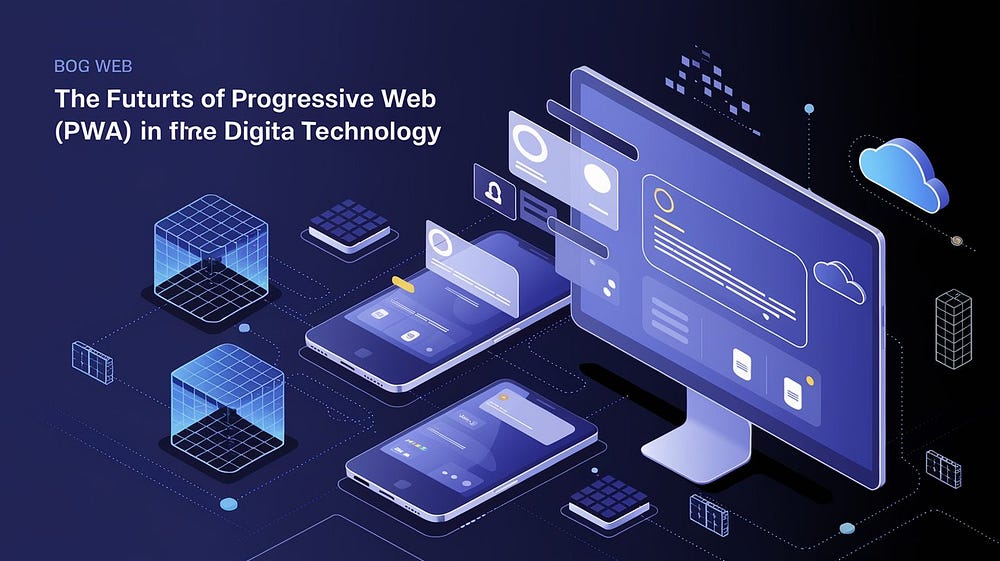Artificial Intelligence (AI) is revolutionizing numerous industries, and the design field is no...
The Future of Progressive Web Apps (PWAs) in the Digital Landscape

In the rapidly evolving world of digital technology, businesses are constantly seeking innovative ways to enhance user experience and engagement. One such innovation that has gained significant traction is Progressive Web Apps (PWAs). Combining the best of web and mobile applications, PWAs offer a seamless and engaging user experience, making them a game-changer in the digital landscape. In this blog, we’ll explore the future of PWAs and their potential impact on businesses and the tech industry.
What Are Progressive Web Apps (PWAs)?
Progressive Web Apps are web applications that provide an app-like experience directly in a user’s browser. They leverage modern web technologies such as service workers, web app manifests, and HTTPS to deliver a fast, reliable, and engaging user experience. PWAs are designed to work on any device with a web browser, making them accessible and versatile.
Key features of PWAs include:
- Offline Capability: Thanks to service workers, PWAs can cache content and function offline or in low-network conditions, enhancing accessibility and reliability.
- Push Notifications: Similar to native apps, PWAs can send push notifications, helping businesses stay connected with users and drive engagement.
- App-like Experience: PWAs are designed to provide an immersive experience with smooth animations, navigation, and responsiveness, akin to native mobile apps.
- Installation Without App Stores: Users can easily add PWAs to their home screens without downloading them from app stores, reducing friction and increasing adoption.
The Rise of PWAs: Why Businesses Are Embracing Them
PWAs have gained popularity due to their ability to bridge the gap between web and mobile experiences. Here are some reasons why businesses are increasingly adopting PWAs:
- Cost-Effective Development: Developing a PWA is generally more cost-effective than building separate native apps for iOS and Android. A single PWA can serve all platforms, reducing development and maintenance costs.
- Improved Performance: PWAs are designed to load quickly, even on slow networks, thanks to their ability to cache data. This results in a smoother and faster user experience, which is crucial for retaining users and reducing bounce rates.
- Enhanced SEO: Unlike native apps, PWAs are indexable by search engines, providing an additional channel for organic traffic. This can significantly boost visibility and reach for businesses.
- Increased Engagement and Conversion Rates: With features like offline access, push notifications, and an app-like experience, PWAs offer higher engagement levels. Studies have shown that PWAs can lead to significant increases in user engagement and conversion rates compared to traditional websites.
The Future of PWAs: Trends and Predictions
As technology continues to advance, PWAs are poised to become even more powerful and influential in the digital landscape. Here are some trends and predictions for the future of PWAs:
- Greater Adoption by Major Platforms and Browsers: With growing support from major browsers and platforms, including Google, Microsoft, and Apple, PWAs are expected to become more mainstream. This increased support will likely lead to broader adoption across industries.
- Integration with IoT and Smart Devices: As the Internet of Things (IoT) continues to expand, PWAs could play a significant role in connecting and controlling smart devices. Their lightweight nature and cross-platform compatibility make them ideal for integration with various IoT applications.
- Advancements in Performance and Capabilities: Ongoing advancements in web technologies will continue to enhance the performance and capabilities of PWAs. Future updates may bring more sophisticated features like augmented reality (AR) and virtual reality (VR) integration, further blurring the line between web and native apps.
- Expansion into Emerging Markets: PWAs are well-suited for emerging markets where internet connectivity may be inconsistent, and high-end devices are less common. Their ability to function offline and on low-end devices makes them a practical solution for businesses looking to reach new audiences in these regions.
- Increased Focus on Security: As PWAs handle more sensitive data and transactions, there will be a greater emphasis on security. Developers will need to adopt best practices in securing PWAs, such as using HTTPS, ensuring robust authentication, and protecting against vulnerabilities.
Challenges and Considerations
While the future of PWAs is promising, there are still challenges to overcome. For instance, not all native app features are fully supported by PWAs, and there are inconsistencies in PWA support across different browsers and platforms. Additionally, some businesses may be hesitant to move away from traditional native apps due to existing investments.
To fully realize the potential of PWAs, continued collaboration between developers, platform providers, and businesses is essential. Addressing these challenges will be key to driving further adoption and innovation in the PWA space.
Conclusion
Progressive Web Apps represent a significant step forward in the evolution of web and mobile experiences. As they continue to grow in popularity and capability, PWAs have the potential to reshape the digital landscape, offering businesses a powerful tool for reaching and engaging users. By staying ahead of the curve and embracing PWAs, businesses can position themselves for success in the increasingly competitive digital world.


